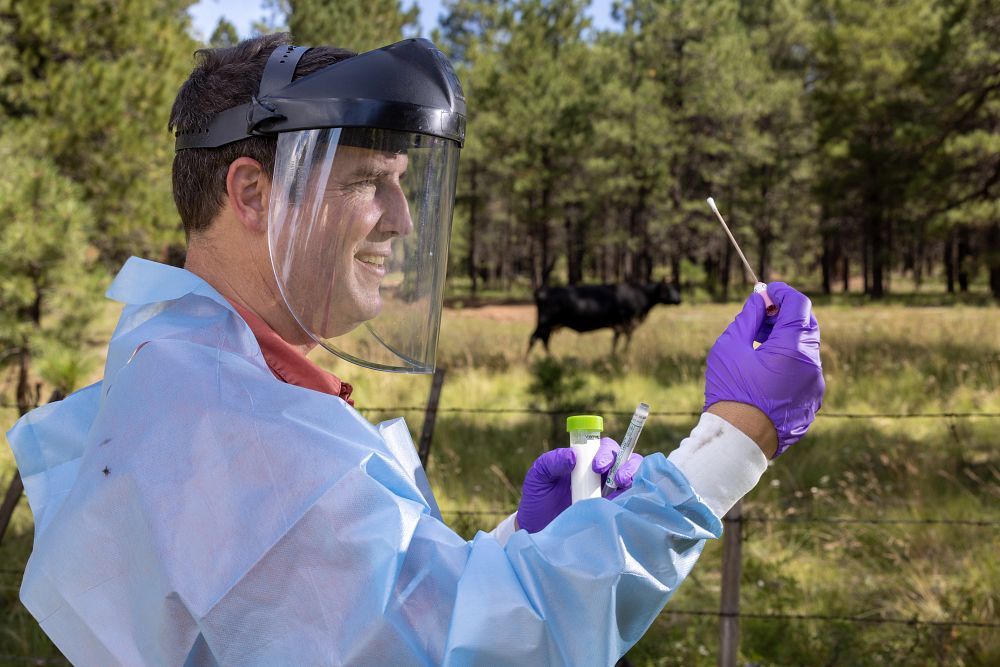Funded through a $3 million grant awarded by the Defense Threat Reduction Agency (DTRA) of the U.S. Department of Defense, associate professor Jeff Foster of Northern Arizona University’s Pathogen and Microbiome Institute recently launched a new effort to study one of the most important infectious diseases in humans and livestock in Iraq.
Although the disease was eradicated long ago in the United States, Canada and parts of Western Europe, brucellosis—caused by the highly infectious bacteria Brucella—remains among the leading communicable diseases worldwide, infecting an estimated 500,000 people and millions of animals each year, including cattle, pigs, sheep, goats and camels. As in many other developing regions, the disease poses a substantial public health burden in the Middle East, resulting in long-term illness in humans and significant economic loss in livestock production.
“The disease is highly prevalent in Iraq and across the region, where animals are extremely valuable to farmers and local economies,” Foster said. “Although livestock can be cured, it takes weeks and sometimes months of antibiotic treatment, which is not economically feasible. The animals become infertile because of the disease, causing a devastating loss of production. Farmers can’t afford to slaughter animals with brucellosis. It causes problems when they try to sell meat and dairy products that have Brucella—and then it puts people at risk for infection.”
Because the disease is widespread, difficult to effectively control and highly infectious, some Brucella are classified as Category B bioterrorism agents by the U.S. Centers for Disease Control and Prevention. Foster believes brucellosis poses a more significant risk than all the other diseases on the bioterrorism list combined, including anthrax, plague and tularemia, simply because it is so common worldwide.
Working with collaborators across Iraq
Foster, whose research focuses on pathogen evolution and disease ecology in wildlife, chiefly bats and birds, is the principal investigator on the three-year project, “Phylogeography of Brucellosis in Iraq.” He will collaborate with Talima Pearson, associate research professor in NAU’s Department of Biological Sciences, and an Iraqi graduate student from the University of Kufa who will join the team at NAU’s Flagstaff campus.
Other collaborators at the University of Kufa as well as Anna Gibson and Jason Farlow from contractor SciLore LLC will work with veterinarians and physicians at select farms, clinics and health agencies in country, collecting samples and conducting genomic sequencing. The DNA testing will help the scientists understand how infected livestock transmit the disease to people and to each other and how to control the disease in both human and animal populations.
“I’m really excited for this work in Iraq,” Foster said. “One of the keys to a successful project is finding really good collaborators to work with. That’s what happened here. I’m excited by the disease, I’m excited by the Iraqi and U.S. collaborators. It’s a really important disease, and it’s worth this type of investment by the government. One of DTRA’s goals is to help researchers in countries like Iraq by providing training and assist with research on infectious diseases—mostly focusing on the scary ones like brucellosis.”
The team will train researchers on the latest techniques in microbiological and epidemiological research, biosafety and genomic analyses as well as tracking the pathogen, which Foster calls a “stealthy” pathogen.
“It’s a pretty cool bug,” he said. “There are particular cells in the body that attack pathogens, and in the case of Brucella, it gets inside the cells that are sent to attack it, so other immune cells can’t find it.”
Approach based on ‘One Health’ concept
The team hypothesizes that the incidence of brucellosis in Iraq is underreported. They also believe that the strains of the pathogen are genetically heterogeneous, but with distinct, detectable lineages. By sequencing Brucella DNA, they will use genomic epidemiology to better understand its prevalence, risk factors, genetic diversity, geographic distribution and transmission.
“Our approach is framed by the ‘One Health’ concept to monitor and control public health threats,” Foster said. “One Health is the idea that human health is inextricably linked to animal health and environmental health and that we can’t treat humans in isolation because our health is interconnected to the health of our animals and the environment. COVID-19 is a great example. We now think of it as a human disease, but it actually originated in wildlife. And if we better understood how the disease was circulating in animals and the environment, we may have known a lot more about how it could potentially affect humans.”
To understand One Health connections among humans, animals and their shared environment, the researchers will use high-resolution genetic subtyping of Brucella samples collected from human and animal populations, including nomadic populations, as well as dairy products from commercial and private farms in Iraq. Their overall objective is to strengthen biosurveillance of brucellosis in human and animal populations in Iraq.
“Ultimately, we want to develop interdisciplinary in-country epidemiological capacity within Iraq that is self-sustaining,” Foster said.
He also is working on another study of brucellosis in Georgia, Turkey and Azerbaijan and will use a similar approach with this project in Iraq, building on the findings of his previous research.
Kerry Bennett | University Marketing




